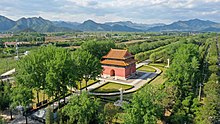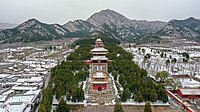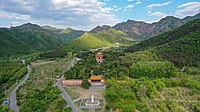| This article needs additional citations for verification. Please help improve this article by adding citations to reliable sources. Unsourced material may be challenged and removed. Find sources: "Ming tombs" – news · newspapers · books · scholar · JSTOR (July 2023) (Learn how and when to remove this message) |
| UNESCO World Heritage Site | |
|---|---|
 Dagong gate (Red in the middle) and Spirit way of the Ming tombs (behind the gate). Dagong gate (Red in the middle) and Spirit way of the Ming tombs (behind the gate). | |
| Location | Beijing and Nanjing, China |
| Criteria | Cultural: i, ii, iii, iv, vi |
| Reference | 1004 |
| Inscription | 2000 (24th Session) |
| Extensions | 2003; 2004 |
| Website | http://www.mingtombs.com/ |
| Coordinates | 40°15′12″N 116°13′3″E / 40.25333°N 116.21750°E / 40.25333; 116.21750 |
The Ming tombs are a collection of mausoleums built by the emperors of the Ming dynasty of China. The first Ming emperor's tomb is located near his capital Nanjing. However, the majority of the Ming tombs are located in a cluster near Beijing and collectively known as the Thirteen Tombs of the Ming dynasty (Chinese: 明十三陵; pinyin: Míng Shísān Líng; lit. 'Ming Thirteen Mausoleums'). They are located within the suburban Changping District of Beijing Municipality, 42 kilometers (26 mi) north-northwest of Beijing's city center. The site, on the southern slope of Tianshou Mountain (originally Huangtu Mountain), was chosen based on the principles of feng shui by the third Ming emperor, the Yongle Emperor. After the construction of the Imperial Palace (Forbidden City) in 1420, the Yongle Emperor selected his burial site and created his own mausoleum. The subsequent emperors placed their tombs in the same valley.
From the Yongle Emperor onwards, thirteen Ming emperors were buried in the same area. The Xiaoling Mausoleum of the first Ming emperor, the Hongwu Emperor, is located near his capital Nanjing; the second emperor, the Jianwen Emperor, was overthrown by the Yongle Emperor and disappeared, without a known tomb. The "temporary" emperor, the Jingtai Emperor, was also not buried here, as the Tianshun Emperor had denied him an imperial burial; instead, the Jingtai Emperor was buried west of Beijing. The last emperor buried at the location was Chongzhen, the last of his dynasty, who committed suicide by hanging on April 25, 1644. He was buried in his concubine Consort Tian's tomb, which was later declared as an imperial mausoleum Siling by the emperor of the short-lived Shun dynasty, Li Zicheng, with a much smaller scale compared to the other imperial mausoleums built for Ming emperors.
During the Ming dynasty, the tombs were off limits to commoners, but in 1644 Li Zicheng's army ransacked and burned many of the tombs before advancing to and subsequently capturing Beijing in April of that year.
In 1725, the Yongzheng Emperor bestowed the hereditary title of marquis on a descendant of the Ming imperial family, Zhu Zhilian, who received a salary from the Qing government and whose duty was to perform rituals at the Ming tombs. He was posthumously promoted to Marquis of Extended Grace in 1750 by the Qianlong Emperor, and the title passed on through twelve generations of Ming descendants until the end of the Qing dynasty.
Presently, the Ming tombs are designated as one of the components of the World Heritage Site, the Imperial Tombs of the Ming and Qing Dynasties, which also includes a number of other locations near Beijing and in Nanjing, Hebei, Hubei, Liaoning province.
Layout




The siting of the Ming dynasty imperial tombs was carefully chosen according to Feng Shui (geomancy) principles. According to these, bad spirits and evil winds descending from the North must be deflected; therefore, an arc-shaped valley area at the foot of the Jundu Mountains, north of Beijing, was selected. This 40 km (15 sq mi) area—enclosed by the mountains in a pristine, quiet valley full of dark earth, tranquil water and other necessities as per Feng Shui—would become the necropolis of the Ming dynasty.
A 7-kilometer (4 mi) road named the "Spirit Way" (pinyin: Shéndào) leads into the complex, lined with statues of guardian animals and officials, with a front gate consisting of a three-arches, painted red, and called the "Great Red Gate". The Spirit Way, or Sacred Way, starts with a huge stone memorial archway lying at the front of the area. Constructed in 1540, during the Ming dynasty, this archway is one of the biggest stone archways in China today.
Further in, the Shengong Shengde Stele Pavilion can be seen; inside, there is a 50-ton stone statue of a Bixi carrying a memorial tablet. Four white marble Huabiao (pillars of glory) are positioned at each corner of the stele pavilion. At the top of each pillar is a mythical beast. Each side of the road is flanked by two pillars whose surfaces are carved with the cloud design, and tops are shaped like a rounded cylinder. They are of a traditional design, and were originally beacons to guide the soul of the deceased, The road leads to 18 pairs of stone statues of mythical animals, which are all sculpted from whole stones and larger than life size, leading to a three-arched gate known as the Dragon and Phoenix Gate.
Map all coordinates using OpenStreetMapDownload coordinates as:
At present, only three tombs are open to the public:
- Changling, the largest (40°18′5.16″N 116°14′35.45″E / 40.3014333°N 116.2431806°E / 40.3014333; 116.2431806 (Chang Ling tomb));
- Dingling, whose underground palace has been excavated (40°17′42.43″N 116°12′58.53″E / 40.2951194°N 116.2162583°E / 40.2951194; 116.2162583 (Ding Ling tomb)); and
- Zhaoling.
There have been no excavations since 1989, but plans for new archeological research and further opening of tombs have circulated.
The Ming tombs were listed as a UNESCO World Heritage Site in August 2003. They were listed along with other tombs under the "Imperial Tombs of the Ming and Qing Dynasties" designation.

List of the Imperial Tombs
The imperial tombs are in chronological order and list the individuals buried:
The Ming emperors not buried in one of the Thirteen Tombs are: Hongwu Emperor, Zhu Biao, Emperor Kang, Jianwen Emperor, Jingtai Emperor, and Zhu Youyuan, Emperor Xian.
 The panorama painting "Departure Herald", painted during the reign of the Jiajing Emperor (1521–1567 AD), shows the emperor traveling on horseback with a large escort through the countryside from Beijing's Imperial City to the Ming tombs.
The panorama painting "Departure Herald", painted during the reign of the Jiajing Emperor (1521–1567 AD), shows the emperor traveling on horseback with a large escort through the countryside from Beijing's Imperial City to the Ming tombs.
Images
-
An entrance to a Ming tomb
-
 Ling'en Hall of Changling Mausoleum
Ling'en Hall of Changling Mausoleum
-
 Shengong Shengde Stele Pavilion at the beginning of the sacred walk leading to the tombs
Shengong Shengde Stele Pavilion at the beginning of the sacred walk leading to the tombs
-
 A statue inside the Ming tombs
A statue inside the Ming tombs
-
A statue inside the Ming tombs
-
 Ling'en Gate of Changling Mausoleum
Ling'en Gate of Changling Mausoleum
-
 A silk burning stove at the Changling Mausoleum
A silk burning stove at the Changling Mausoleum
-
 Minglou Tower of Changling Mausoleum
Minglou Tower of Changling Mausoleum
See also
- Ming Xiaoling Mausoleum in Nanjing
- Ming Ancestors Mausoleum in Jiangsu Province
- Eastern Qing tombs near Beijing
- Western Qing tombs near Beijing
- The three imperial tombs north of the great wall
- Fuling Tomb east of Shenyang in Liaoning
- Zhao Mausoleum north of Shenyang in Liaoning
- Yongling Tombs east of Fushun in Liaoning
References
External links
- Imperial Tombs of the Ming and Qing Dynasties on the UNESCO World Heritage List
| World Heritage Sites in China | ||
|---|---|---|
| East |
| [REDACTED] |
| South Central |
| |
| Southwestern | ||
| North | ||
| Northeast | ||
| Northwestern | ||
| Multiple regions |
| |
- 15th-century architecture
- 15th century in China
- 16th-century architecture
- 16th century in China
- 17th-century architecture
- 17th century in China
- Buildings and structures in Beijing
- Cemeteries in Beijing
- Burial sites of the Ming dynasty
- Changping District
- Major National Historical and Cultural Sites in Beijing
- Mausoleums in China
- Ming dynasty architecture
- Tourist attractions in Beijing
- World Heritage Sites in China












